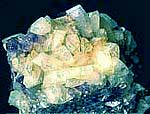euclase
 Mineral characteristic.
Mineral characteristic.
Silicate of aluminum and beryllium, found in the form of small crystals: colorless, pale green, blue, blue-green, yellow-green, yellow, and rarely - emerald green. Stone resembles in appearance opal (which never occurs in crystals). Euclase - very beautiful stone is rare and therefore quite expensive. In private collections, this mineral is difficult to meet. Diagnosis and identification of this mineral is better to entrust to specialists.
Euclase belongs to the less common minerals. Strong luster, beautiful color, high hardness enough - on these grounds it could take its rightful place among the most expensive gemstones. But, unfortunately, it has a very fragile euclase (on its Urals called hrupikom) and perfect cleavage (in Greek. Fissionable well), making it extremely uncomfortable material for cutting. Euclase crystal size is usually small: as a rule, no more than 3 mm, rarely to 1.5 cm were used for cutting only a few stones from Brazil and the Urals.. The most famous are the stones from Brazil. Basically euclase crystals adorn the collections of mineralogical museums in the world. Euclase, especially in the faceted form, color and some physical properties similar to beryl (especially aquamarine) Phenacite, kyanite, chrysoberyl.
In nature euclase occurs in the form of plate-prismatic, plate, short- and dlinnoprizmaticheskih crystals with a large number of faces. Number of simple forms known to euclase crystals is very large. Transparent crystals euclase may be colorless or blue, blue, bluish, yellowish and bluish-green. When friction is electrified. In some crystals observed zonal uneven coloration with colorless or yellowish and dark-colored areas. Zoning is also possible in spherulites and sheaf-like aggregates, which are on the periphery are sometimes painted in bright blue, and the center is almost colorless.
The magical properties of stones.
This mascot people experienced, lived many interesting situations, able to draw the right conclusions and learn not only from their own experience, but also the experience of others. So people euclase opens many perspectives, gives them even greater insight, the ability to own difficult situations, opportunities to navigate the criminal coincidence of circumstances, but young and inexperienced people he was completely useless. Euclase powerfully nourishes its owner's energy and helps direct it in a constructive direction. Stone - an excellent mascot practicing magicians and "wizards" of various profiles.
It is believed that this stone is somewhat similar in its characteristics to Opal, at least in the sense both of these stones are on the illusion that prevent the development of human and distracting. Euclase - stone of the same dangerous, but only dangerous for young people. It is a stone of mature people.
It is believed to exert its positive effects only on people who have reached the age of Jupiter (45 years old). And it distracts young, awakens the anarchist tendency, too much need for freedom. It is a stone of mature people. Awaken the power of stone can only be a strong man. Euclase very difficult to awaken. It is well affects the elderly, when the person can give himself the tradition and can lay the foundations kind.
Any of the stones used in magic, but pure magic stones little. Euclase is one of them. He is elusive and changeable. Best of all it works on those people whom he inherited or presented a very congenial person, close friend, etc. Here it is necessary to monitor its energies. With euclase come to dead ancestors and work with them.
Toxic and hazardous radioactive rocks and minerals
** - Poisonous stones and minerals (obligatory check in chemical laboratory + clear indication of toxicity).
** - Radioactive rocks and minerals (obligatory check on a regular dosimeter + ban on the open sale of radioactivity in the event of more than 24 mR / hour + additional measures to protect the population).
All rare stones should always be checked on a regular dosimeter on the permissible level of radiation and a chemical laboratory in the absence of toxic and volatile components which are hazardous to humans and the environment.


Comments
Commenting, keep in mind that the content and the tone of your messages can hurt the feelings of real people, show respect and tolerance to his interlocutors, even if you do not share their opinion, your behavior in terms of freedom of speech and anonymity offered by the Internet, is changing not only virtual, but real world. All comments are hidden from the index, spam control.